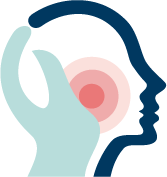
OUR TREATMENTS
Our practice is limited to the treatment of TMJ Pain, Orofacial Pain, Oral Diseases and Disorders and Oral Appliance Therapy for Snoring and Obstructive Sleep Apnoea.
TMJ PAIN
Temporomandibular joints (TMJs) or jaw joints must be functioning properly in order to open and close your mouth, to eat or speak. The TMJs allow the jaw to be moved by your jaw muscles and are stabilized by ligaments. Similar to other orthopaedic systems these structures can be compromised by trauma, overuse, and disease with the potential for a wide variety of symptoms.
Temporomandibular Disorders (TMD) are a group of disorders, with similar symptoms affecting the TMJ and related structures.
NERVE PAIN
Neuropathic pain disorders arise from disorder or injury to the nervous system. Neuropathic Orofacial Pain disorders are often chronic and arise from the nerves affecting the head, face and mouth.
The nervous system can be divided into two general parts: the central portion, which includes the brain and spinal cord, and the peripheral part, which includes the nerves that go to such outlying areas of the body as the arms, legs, trunk, face and teeth. The peripheral nerves have special receptors which when stimulated by pressure, heat, chemicals or pain, begin firing electrical impulses back along the nerve. The nerves course their way into the spinal cord where they connect to a second nerve which extends up the spinal cord to the brain where the information is processed. In the brain, a different nerve continues to carry the message to other parts of the brain where the message is actually interpreted. The brain has many complex chemical mechanisms to either increase or decrease the pain-related information streaming into it.
If a peripheral nerve is injured, for example a tooth has a nerve injury from decay and subsequent root canal treatment, one might correctly expect that the tooth would be sore for several days. Sometimes, however, the tooth continues to hurt for months and even years. Even more perplexing, the tooth may be extracted and can continue to hurt as if it were still there.
SNORING AND SLEEP APNOEA
Sleep disorders are as individual as you are, because they are influenced by your body size, shape and overall health. That is why an individualized approach to your sleep treatment is so important.
Sleep Apnoea is a common sleeping disorder marked by shallow breathing, pauses in breath and labored breathing punctuated by gasping or snoring sounds. Pauses of breath can last from several seconds up to minutes and can happen from five to thirty times or more per hour. A pause may be followed by a choking or snorting sound as the sleeper involuntarily gasps for breath.
As oxygen is restricted to the lungs, blood and brain, the sleeper is less likely to fall into deep, or REM sleep. A lack of quality sleep can lead a variety of serious health concerns including heart disease, high blood pressure, stroke, diabetes and depression.
HEADACHES
A headache is an ache or pain occurring anywhere in the face, neck or head. Headache pain is experienced through pain-sensitive structures around the head and neck including blood vessels, nerves, muscles and tissues including the eyes, ears and sinuses. Headaches can range across the intensity spectrum from mild, tolerable pain to severe pain that prohibits daily activities. Headaches are one of the most commonly experienced causes of pain. They can be occasional, recurrent or chronic in frequency.
The International Classification of Headache Disorders (ICHD) is published by the International Headache Society to classify and diagnose types of headaches. There are many ways of classifying headache. The major distinction is between primary headache (when there is no underlying illness or other cause) and secondary headache (when a specific cause is identifiable).
If a person has a stable pattern of headache, even if disabling, he or she most likely has a primary headache disorder. Atypical features or recent changes in headache pattern increase the possibility that a headache is secondary to some other medical condition.There are four primary types of headaches: migraines, tension-type headaches, cluster headaches and other headaches sensed in the cranial nerves. Different types of headaches may respond to different types of treatments as they originate by various causes.
